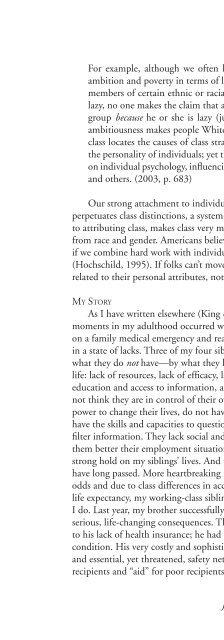WINTER 2012 - National Association of Schools of Public Affairs and ...
WINTER 2012 - National Association of Schools of Public Affairs and ...
WINTER 2012 - National Association of Schools of Public Affairs and ...
You also want an ePaper? Increase the reach of your titles
YUMPU automatically turns print PDFs into web optimized ePapers that Google loves.
Amy E. Smith <strong>and</strong> Ignacio J. Martinez-Moyano<br />
McCarthy, 2007; S<strong>and</strong>erson, 2002). The extent <strong>and</strong> adequacy <strong>of</strong> research use<br />
depends on the existence <strong>of</strong> both (a) high-quality research that is relevant for<br />
practice <strong>and</strong> (b) adequate quantitative skills to underst<strong>and</strong> <strong>and</strong> use such research<br />
(e.g., statistical knowledge). Our goal is to identify <strong>and</strong> describe techniques used<br />
by experienced statistics instructors to address challenges inherent in teaching<br />
statistics in practitioner-oriented master’s degree programs.<br />
Problems managers face are messy <strong>and</strong> ill defined (Ack<strong>of</strong>f, 1974;<br />
Churchman, 1967; Conklin, 2006; Horn, 2001; Rittel & Webber, 1973). When<br />
faced with a task or problem, practitioners need to be able to think critically,<br />
distinguish what is relevant from what is not, consider facts <strong>and</strong> relationships,<br />
systematically uncover alternatives, determine the effectiveness <strong>of</strong> programs <strong>and</strong><br />
projects, use persuasive reasoning to support claims, <strong>and</strong> use data to inform<br />
decisions (Desai, 2008; Hill & Lynn, 2009; Hodges, 1996; Toulmin, 1964;<br />
Williams, Colomb, D’Errico, & Tracey, 2003). Thus, the ability to effectively<br />
explore existing theories <strong>and</strong> empirical research on what other practitioners <strong>and</strong><br />
researchers have done or considered in similar situations is critical (Fitzpatrick,<br />
2000; Meier, Brudney, & Bohte, 2006; Van de Ven & Johnson, 2006).<br />
However, practitioners do not always make decisions informed by research <strong>and</strong><br />
evidence (Desai, 2008; Rousseau, 2006). What can we do to make practitioners<br />
better consumers <strong>of</strong> research? This paper explores one possible answer to this<br />
question—namely, to help instructors develop the tools <strong>and</strong> skills they need to<br />
grow “reflective practitioners” (Davenport & Markus, 1999; Rousseau, 2006, p.<br />
20). While high-quality empirical research takes many forms, this project focuses<br />
only on quantitative, in particular, statistical empirical research.<br />
In this project, we identified the challenges facing statistics instructors <strong>and</strong><br />
some <strong>of</strong> the practices for addressing these challenges. We employed a sample<br />
<strong>of</strong> experienced statistics instructors in the social sciences to identify the tools<br />
<strong>and</strong> techniques that are most effective in addressing the challenges inherent in<br />
teaching statistics to students enrolled in practitioner-oriented master’s degree<br />
programs. We distinguish practitioner-oriented master’s programs from other<br />
master’s degree programs in that individuals attending such programs are<br />
nonspecialists in the field <strong>of</strong> statistics. Students <strong>of</strong> this type <strong>of</strong> program tend to<br />
be consumers, rather than producers, <strong>of</strong> statistical research.<br />
This paper is divided into five sections. The first section reviews literature<br />
relevant to teaching statistics <strong>and</strong> discusses the use <strong>of</strong> the Delphi technique as<br />
a research method. The second section describes the data collection techniques<br />
<strong>and</strong> the methods used to analyze the data. The third section presents findings,<br />
implications, <strong>and</strong> discussion <strong>of</strong> our analysis. The fourth section describes an<br />
extended version <strong>of</strong> the model presented in Figure 1 <strong>of</strong> the introduction. The<br />
paper concludes with a discussion including limitations, contributions, <strong>and</strong><br />
directions for future research.<br />
110 Journal <strong>of</strong> <strong>Public</strong> <strong>Affairs</strong> Education

















